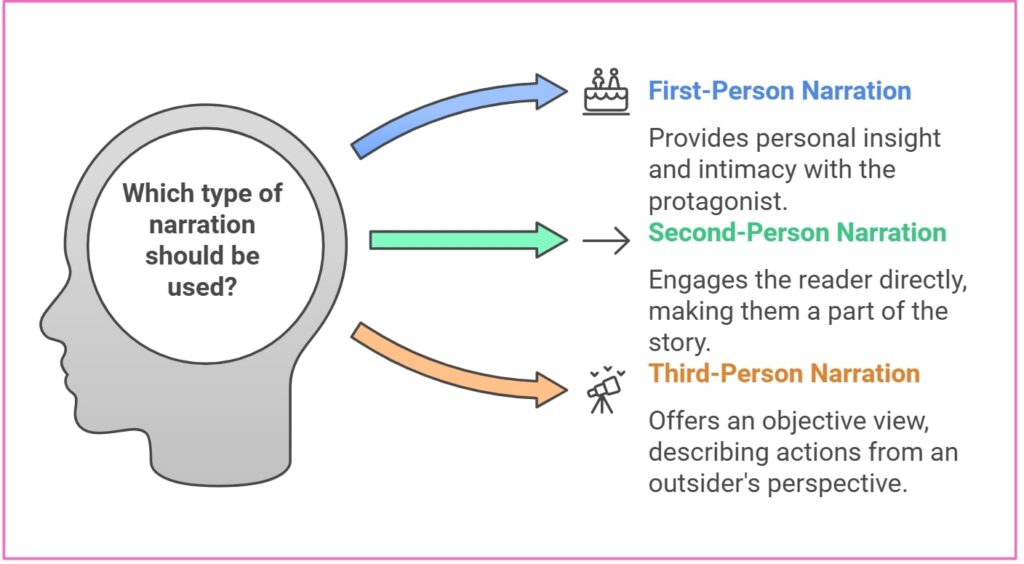Ever struggled to explain what someone said in their exact words or your own? That’s where narration steps in. Narration, the art of telling a story or reporting speech, comes in various forms. From quoting directly to paraphrasing smoothly, mastering narration can enhance your communication skills in writing, speaking, and beyond.
In this post, we’ll explore the concept of narration, Definition of Narration Types of Narration Examples With Answers. Packed with examples and exercises, this guide will help you confidently navigate the world of narration. Let’s start to learinig.
 Types of Narration
Types of Narration
Contents
ToggleWhat is Narration?
Narration is the act of telling or reporting events, stories, or speech. It’s a fundamental aspect of communication that helps us share information effectively.
Types of Narration
- First-Person Narration:
- The narrator is the protagonist or a character in the story.
- Example: “I love baking chocolate cakes.”
- Second-Person Narration:
- The narrator addresses the reader directly using “you.”
- Example: “You need to add sugar to balance the bitterness of the chocolate.”
- Third-Person Narration:
- The narrator tells the story from an outsider’s perspective.
- Example: “David baked a chocolate cake for his friend.”
What is Direct and Indirect Speech?
Direct Speech
- Definition: Direct speech quotes the speaker’s exact words, typically enclosed in quotation marks.
- Example:
- Sarah said, “I am learning Spanish.”
Indirect Speech
- Definition: Indirect speech reports the speaker’s words without quoting them verbatim.
- Example:
- Sarah said that she was learning Spanish.
Rules for Converting Direct to Indirect Speech
Converting direct to indirect speech involves some key rules depending on pronouns, tenses, sentence types, and adverbs.
1. Pronoun Changes
Pronouns shift based on the speaker and listener.
- Examples:
- Direct: “I love apples,” said John.
- Indirect: John said that he loved apples.
- Direct: “Can you help me?” she asked.
- Indirect: She asked if I could help her.
- Direct: “I love apples,” said John.
2. Tense Changes
Tenses usually move one step back in time.
- Examples:
- Present Simple → Past Simple
- Direct: “I enjoy reading,” said Emma.
- Indirect: Emma said that she enjoyed reading.
- Present Continuous → Past Continuous
- Direct: “I am cooking dinner,” he said.
- Indirect: He said that he was cooking dinner.
- Past Simple → Past Perfect
- Direct: “I visited Paris last year,” she said.
- Indirect: She said that she had visited Paris the previous year.
- Present Simple → Past Simple
- Exception: If the fact is universally true, the tense doesn’t change.
- Direct: “The Earth revolves around the sun,” he said.
- Indirect: He said that the Earth revolves around the sun.
3. Sentence Types
a. Interrogative Sentences
- Yes/No Questions → Use “if” or “whether.”
- Direct: “Are you coming?” he asked.
- Indirect: He asked if I was coming.
- WH-Questions → Use the question word directly.
- Direct: “Where are you going?” she asked.
- Indirect: She asked where I was going.
b. Imperative Sentences
- Add “to” or “not to” before the verb.
- Direct: “Close the door,” she said.
- Indirect: She told me to close the door.
c. Exclamatory Sentences
- Replace interjections with appropriate reporting verbs.
- Direct: “Wow! That’s amazing,” she said.
- Indirect: She exclaimed that it was amazing.
4. Adverbs and Demonstratives
Time and place expressions change to reflect the context.
- Examples:
- Direct: “I will meet you here tomorrow,” he said.
- Indirect: He said that he would meet me there the next day.
- Direct: “I saw him yesterday,” she said.
- Indirect: She said that she had seen him the day before.
- Direct: “I will meet you here tomorrow,” he said.
Examples and Exercises
Examples
- Direct: “I will call you later,” she said.
- Indirect: She said that she would call me later.
- Direct: “What are you doing?” he asked.
- Indirect: He asked what I was doing.
- Direct: “Don’t touch that!” the teacher warned.
- Indirect: The teacher warned me not to touch that.
Exercises
Convert the following sentences into indirect speech:
- Direct: “I am working on a project,” he said.
- Direct: “Did you finish your homework?” she asked.
- Direct: “Please pass me the salt,” he requested.
- Direct: “Hurray! We won the match,” they exclaimed.
- Direct: “We are planning a trip to Europe,” they said.
Answers
- He said that he was working on a project.
- She asked if I had finished my homework.
- He requested me to pass him the salt.
- They exclaimed with joy that they had won the match.
- They said that they were planning a trip to Europe.
Common Mistakes to Avoid
- Forgetting Pronoun Shifts: Ensure pronouns match the subject and listener in the reported speech.
- Incorrect Tense Changes: Check if the original statement is a universal truth before changing the tense.
- Misusing Reporting Verbs: Use verbs like “asked,” “told,” “requested,” or “exclaimed” appropriately based on the sentence type.
FAQs About the Definition of Narration types of Narration
1. What is narrative definition and types?
- Narrative is a story or account of events. Types of narration include:
- First-Person: Narrator is a character using “I.”
- Second-Person: Narrator uses “you.”
- Third-Person: Narrator is outside the story using “he,” “she,” or “they.”
- Omniscient: Narrator knows all characters’ thoughts.
- Limited: Narrator knows only one character’s thoughts.
2. What is the short definition of narration?
- Narration is the act of telling a story or describing events.
3. How many types of narration sentences are there?
- Three types:
- Direct Narration: Direct quotes.
- Indirect Narration: Paraphrasing.
- Free Indirect Narration: Mixing both direct and indirect speech.
4. What are the different types of narrators?
- Types of narrators include:
- First-Person: Character in the story.
- Third-Person Limited: Knows one character’s thoughts.
- Third-Person Omniscient: Knows all characters’ thoughts.
- Unreliable: May mislead the reader.
- Objective: Only describes actions and dialogue.
Learning narration, particularly the art of converting direct speech into indirect speech, is a valuable skill in communication. With the rules, examples, and exercises provided here, you’re well-equipped to confidently use both forms of speech. Now, it’s your turn—practice these conversions and see how you can make your communication smoother and more effective.

